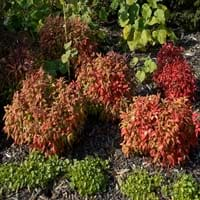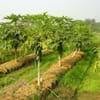Life Span
Annual and Perennial
Perennial
Type
Fruit
Broadleaf Evergreen
Origin
Mexico, Central America
China, Japan
Types
Male Papaya Tree, Female Papaya Tree, hermaphrodite Tree
Heavenly Bamboo, Nandina 'Colerno'
Dwarf Nandina 'Compacta'
Dwarf Nandina 'Filamentosa'
Heavenly Bamboo, Nandina 'Harbor Belle'
Heavenly Bamboo, Nandina 'Moon Bay'
Number of Varieties
Not Available
Habitat
tropical environments, Tropical regions
low mountains, Mountain tops, Mountains, Valley
USDA Hardiness Zone
10-15
6-11
AHS Heat Zone
12-10
Not Available
Sunset Zone
H1, H2, 21, 23, 24
21,22
Habit
Upright/Erect
Clump-Forming
Flower Color
Ivory
Not Available
Flower Color Modifier
Bicolor
Bicolor
Fruit Color
Green, Orange, Light Yellow
Not Available
Leaf Color in Spring
Dark Green
Green, Purple, Copper
Leaf Color in Summer
Dark Green
Green, Purple
Leaf Color in Fall
Dark Green
Green, Purple
Leaf Color in Winter
Light Green
Red, Green, Purple
Leaf Shape
Irregular
Acuminate
Plant Season
Spring, Summer, Fall, Winter
Spring, Summer, Fall, Winter
Sunlight
Full Sun, Partial Sun, Partial shade
Full Sun, Partial Sun, Partial shade, Full Shade
Growth Rate
Very Fast
Medium
Type of Soil
Loam, Sand, Well drained
Loam, Sand
The pH of Soil
Acidic, Neutral
Acidic, Neutral, Alkaline
Soil Drainage
Well drained
Well drained
Bloom Time
Indeterminate
Not Available
Tolerances
Drought
Drought
Where to Plant?
Ground
Ground
How to Plant?
Seedlings
Seedlings
Plant Maintenance
Medium
Medium
Watering Requirements
Average Water Needs, Do Not over Water, Do not water frequently, Requires watering in the growing season
Do not water frequently, Needs less watering
In Summer
Lots of watering
Lots of watering
In Spring
Moderate
Moderate
In Winter
Average Water
Average Water
Soil pH
Acidic, Neutral
Acidic, Neutral, Alkaline
Soil Type
Loam, Sand
Loam, Sand
Soil Drainage Capacity
Well drained
Well drained
Sun Exposure
Full Sun, Partial Sun, Partial shade
Full Sun, Partial Sun, Partial shade, Full Shade
Pruning
Remove damaged leaves, Remove dead branches, Remove dead leaves, Remove shoots, Remove short branches, Remove short twigs, Requires little pruning
Remove damaged leaves, Remove dead branches, Remove dead leaves
Fertilizers
14-14-14 Fertilizer
All-Purpose Liquid Fertilizer
Pests and Diseases
Red blotch
Red blotch
Plant Tolerance
Drought
Drought
Flower Petal Number
Single
Not Available
Foliage Texture
Bold
Fine
Foliage Sheen
Glossy
Glossy
Attracts
Ants, Bees, Hummingbirds
Mealybugs, Whiteflies
Allergy
Asthma, breathing problems, Itchiness, Itchy eyes, Red eyes, Runny nose, sneezing, Sore eyes, Swelling, Watery eyes, wheezing
Not Available
Aesthetic Uses
Not Used For Aesthetic Purpose
Bonsai, Borders
Beauty Benefits
Good for skin, Good for skin and hair, Improve hair condition, Making cosmetics, Not Available
Not Available
Environmental Uses
Air purification
Air purification
Medicinal Uses
Asthma, Bone strength, Cancer, Diabetes, Digestion problems, Heart problems, Inflammation, Skin Disorders
Antirheumatic, Antitussive, Astringent
Part of Plant Used
Fruits, Seeds
Fruits, Leaves
Other Uses
Cosmetics, Making Shampoo, Used As Food, Used for its medicinal properties
Used for making informal hedge
Used As Indoor Plant
No
No
Used As Outdoor Plant
Yes
Yes
Garden Design
Container, Edible, Feature Plant, Fruit / Fruit Tree, Tropical
Container, Edging, Foundation, Groundcover, Hedges, Mixed Border, Topiary, Bonsai, Espalier
Botanical Name
CARICA papaya
NANDINA domestica 'Nana Purpurea'
Common Name
Papaya
heavenly bamboo
sacred bamboo
nandina
In Hindi
पपीता
Dwarf Nandina
In German
Papaya
Dwarf Nandina
In French
Papaye
Nandina Dwarf
In Spanish
Papaya
Nandina enana
In Greek
Παπάγια
Dwarf Nandina
In Portuguese
Mamão
Nandina do anão
In Polish
Papaja
Dwarf Nandina
In Latin
Papaya
Dwarf Nandina
Phylum
Magnoliophyta
Tracheophyta
Class
Magnoliopsida
Magnoliopsida
Order
Brassicales
Ranunculales
Family
Caricaceae
Berberidaceae
Clade
Angiosperms, Eudicots, Rosids
Angiosperms, Eudicots
Tribe
Not Available
Not Available
Subfamily
Not Available
Not Available
Number of Species
Not Available
Not Available
Importance of Papaya and Dwarf Nandina
Want to have the most appropriate plant for your garden? You might want to know the importance of Papaya and Dwarf Nandina. Basically, these two plants vary in many aspects. Compare Papaya and Dwarf Nandina as they differ in many characteristics such as their life, care, benefits, facts, etc. Every gardener must at least have the slightest clue about the plants he wants to plant in his garden. Compare their benefits, which differ in many ways like facts and uses. The medicinal use of Papaya is Asthma, Bone strength, Cancer, Diabetes, Digestion problems, Heart problems, Inflammation and Skin Disorders whereas of Dwarf Nandina is Antirheumatic, Antitussive and Astringent. Papaya has beauty benefits as follows: Good for skin, Good for skin and hair, Improve hair condition, Making cosmetics and Not Available while Dwarf Nandina has beauty benefits as follows: Good for skin, Good for skin and hair, Improve hair condition, Making cosmetics and Not Available.
Compare Facts of Papaya vs Dwarf Nandina
How to choose the best garden plant for your garden depending upon its facts? Here garden plant comparison will help you to solve this query. Compare the facts of Papaya vs Dwarf Nandina and know which one to choose. As garden plants have benefits and other uses, allergy is also a major drawback of plants for some people. Allergic reactions of Papaya are Asthma, breathing problems, Itchiness, Itchy eyes, Red eyes, Runny nose, sneezing, Sore eyes, Swelling, Watery eyes and wheezing whereas of Dwarf Nandina have Not Available respectively. Having a fruit bearing plant in your garden can be a plus point of your garden. Papaya has showy fruits and Dwarf Nandina has no showy fruits. Also Papaya is flowering and Dwarf Nandina is not flowering . You can compare Papaya and Dwarf Nandina facts and facts of other plants too.





